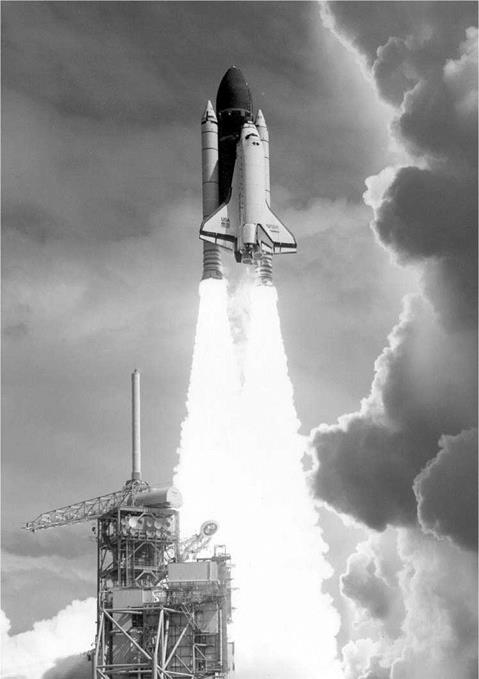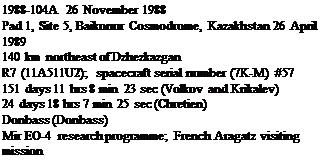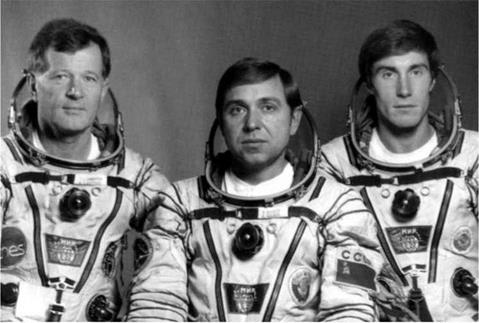STS-26
|
Int. Designation |
1988-091A |
|
Launched |
29 September 1988 |
|
Launch Site |
Pad 39B, Kennedy Space Center, Florida |
|
Landed |
3 October 1988 |
|
Landing Site |
Runway 17, Edwards Air Force Base, California |
|
Launch Vehicle |
OV-103 Discovery/ET-28/SRB BI-029/SSME #1 2019; |
|
#2 2022; #3 2028 |
|
|
Duration |
4 days 1 hr 0 min 11 sec |
|
Callsign |
Discovery |
|
Objective |
Return-to-Flight mission; TDRS-C deployment |
Flight Crew
HAUCK, Frederick Hamilton “Rick”, 47, USN, commander, 3rd mission Previous missions: STS-7 (1983); STS 51-A (1984)
COVEY, Richard Oswalt, 42, USAF, pilot, 2nd mission Previous mission: STS 51-1 (1985)
LOUNGE, John Michael, 38, civilian, mission specialist 1, 2nd mission Previous mission: STS 51-1 (1985)
HILMERS, David Carl, 38, USMC, mission specialist 2, 2nd mission Previous mission: STS 51-J (1985)
NELSON, George Driver, 38, civilian, mission specialist 3, 3rd mission Previous missions: STS 41-C (1984); STS 51-C (1985)
Flight Log
Following the release of the findings of the Rogers Commission into the Challenger disaster in June 1986, NASA was directed to follow nine major recommendations to improve the safety and management of the Space Shuttle programme. The path to recovery was a tortuous one. At first, a re-launch in late 1987 seemed a possibility, or early 1988, or June 1988. Discovery finally and patriotically made it to the pad on 4 July. A successful launch and flight of the Space Shuttle was considered crucial. It was to be the most important manned mission of the US space programme. A failure of any kind could have spelled the death knell of the programme and NASA knew it. No. chances were being taken; so much so that many experienced space watchers reckoned that a few abortive countdowns were going to be unavoidable and once Discovery did take off, it would be an anticlimax, perhaps what NASA wanted.
True to form, as the all-veteran crew of STS-26 – a Shuttle first – left the crew quarters on 29 September, looking like astronauts again wearing high-altitude pressure suits, the chances of launching that day were put at 50-50, mainly because the winds at high altitude were not strong enough. The flight computer was programmed

|
to expect stronger seasonal winds. It was re-programmed during holds caused by other niggling problems and the count stood at T — 9 minutes for 1 hour 38 minutes. The go for launch was suddenly given and people realised that perhaps Discovery was going to get off first time after all. Things went well until it was announced that the count would hold at T — 31 seconds because a problem had been experienced. This proved to be an erroneous switch and at 11: 37 hrs local time, on Challenger’s Pad 39B, America returned to space with a smooth lift-off and ascent.
Concern was caused by the sight of flames around the SRBs just before burn out but these were caused by the SSME exhaust being sucked into an aerodynamically low pressure area of the Shuttle stack as it rose at Mach 4. It was all so smooth that observers did indeed feel the anticlimax, a tribute to the launch team under former astronaut Bob Crippen. The STS-26 mission continued on its winning way, performing an OMS burn to circularise the 29.45° orbit at 284 km (176 miles), and deploying the TDRS-C satellite on its IUS upper stage.
The crew conducted several science experiments, practiced donning and doffing the ascent/descent suit to see how quickly it could be done in an emergency, and experienced, for a short while, uncomfortably high cabin temperatures of 29°C due to ice blocking a cooling duct. On day four, the crew made a moving tribute to the Challenger Seven, covered live on TV. The flight was also a re-qualification of Discovery within the Return-to-Flight programme.
Only the landing remained. The de-orbit and re-entry were routine and Discovery came home in triumph, to a rapturous welcome from observers at Edwards Air Force Base, including Vice President George Bush, landing on runway 17 at T + 4 days 1 hour 0 minutes 11 seconds. The Shuttle was poised for routine operations again but the difference was that even NASA admitted that things could go wrong again, something that before Challenger would have seemed a sacrilege, such was the apparent ease and safety of the system.
Milestones
121st manned space flight 56th US manned space flight 26th Shuttle flight 7th flight of Discovery 3rd TDRS deployment mission

 |
Flight Crew
VOLKOV, Aleksandr Aleksandrovich, 40, Soviet Air Force, commander, 2nd mission
Previous mission: Soyuz T14 (1985)
KRIKALEV, Sergei Konstantinovich, 30, civilian, flight engineer CHRETIEN, Jean-Loup, 50, French Air Force, cosmonaut researcher, 2nd mission
Previous mission: Soyuz T6 (1982)
Flight Log
France’s close ties with the Soviet space programme produced beneficial results, none more so than the Soyuz TM7 mission in which the highest ranking spaceperson, Brigadier General Jean-Loup Chretien would make his second flight on a Soviet spacecraft and be the first non-US and non-Soviet spaceman to walk in space. His 30-day mission would also be considerably longer than the usual seven-day jaunts by foreigners. The longer flight was provided in return for the supply of much French scientific equipment for use by the Soviet crews on Mir, but it was the last to be provided free by the Soviets; the next Frenchman had to pay $12 million.
France’s President Mitterand scored a spectacular own goal before the mission by insisting on going to Baikonur to watch the launch, which would therefore have to be delayed four days to 26 November, reducing Chretien’s time in space. Mitterand winged his way in and out of Baikonur on a Concorde with an entourage of such high number and rank that Baikonur’s modest hospitality facilities and traditional prelaunch pomp and circumstance became unmanageable. The result was a chaotic crew walk out in which Mitterand and other officials were bundled about by hordes
|
French cosmonaut Chretien (left) joins his Soviet colleagues Volkov (centre) and Krikalev for the Soyuz TM7 crew photo |
of eager bystanders and press, as crew commander Aleksandr Volkov tried to make his traditional speech of dedication of the mission to General Kerim Kerimimov, the president of the state commission.
The launch, the 301st from Pad 1 at Baikonur, was spectacularly routine, with the Soyuz booster that had only been rolled out to the fog-bound pad two days previously lighting up the sky at 20:49hrs local time. Once aboard Mir, after the two-day rendezvous flight, Chretien, Volkov and the impassive young flight engineer Sergei Krikalev, got to work with Titov, Manarov and Polyakov, the high point of which was Chretien’s EVA with Volkov on 9 December, three days earlier than planned originally. During the 5 hour 57 minute EVA, Chretien and Volkov deployed an experiment called ERA, provided by France, which comprised folded carbon fibre tubes that could be unfurled to form a cube structure in a test of erectable space structures. The $8 million experiment seemed doomed to failure when it could not be commanded to unfurl and engineers considered jettisoning it. Volkov saved the day – he admitted later – by giving it a hefty kick with his space boot. Both spacemen were utterly exhausted by their efforts.
The fruitful French mission ended with Chretien returning to Earth with the record-breakers Titov and Manarov on 21 December, leaving Volkov, Krikalev and the doctor Polyakov to remain until 27 April, to be replaced by the TM8 crew. The fresh Soyuz TM7 craft was moved to the front and Progress 39 linked up on 27 December with New Year supplies.
Delays in launching new modules to Mir meant that this crew, like previous ones on Mir, were rather limited in what experiments they could conduct, most of which seemed to focus on the astrophysics telescopes on the Kvant module and Polyakov’s surgery. The crew also spent much of their time repairing balky equipment, particularly environmental control systems which were misbehaving so badly that some electrical equipment was covered in condensation. The module delays and these niggling equipment problems raised concerns over whether Mir, three years old on 20 February 1989, would ever see out its operational life before being declared operational with all four modules.
But life went on. Progress 40 replaced No.39 on 12 February, delivering pickled cucumbers by request. A planned EVA by Volkov and Krikalev was cancelled and there were suggestions that Polyakov might remain on Mir with the next crew. When Progress 40 departed on 3 March it remained close to Mir for the cosmonauts to observe a unique experiment in which the unmanned tanker deployed two folding structures, which were unfurled from it by heating electrical wires in its body in a space structures test. Progress 40 was destroyed during a controlled re-entry two days later and was replaced by Progress 41 on 18 March.
Meanwhile, on the ground, cosmonauts Aleksandr Viktorenko and Aleksandr Balandin, the latter having replaced Aleksandr Serebrov because of the delays in the launches of the new modules which Serebrov had been trained specifically to operate, were ready to launch on 19 April onboard Soyuz TM8, to replace the crew of TM7 which was to come home with Polyakov on 27 April. Then, on 12 April, the Soviets sprang a surprise, saying that the Soyuz TM7 crew would leave Mir empty for several months. Flying another crew when the new modules were not ready for launch seemed wasteful and leaving Mir empty would save money. So Volkov and Krikalev clocked up a TM7 flight time of 151 days 11 hours 10 minutes, landing on 27 April northeast of Dzhezkazgan, the prime recovery zone, as planned. Polyakov had clocked up 240 days 22 hours 36 minutes flight time, the fourth longest individual space mission.
Milestones
122nd manned space flight 66th Soviet manned space flight 59th Soyuz manned space flight 6th Soyuz TM manned space flight 6th Soyuz international mission
1st non-Soviet, non-US crewman to make two space flights 1st non-Soviet, non-US crewman to perform EVA 14th Soviet and 37th flight with EVA operations
Volkov celebrates his 41st and Polyakov his 47th birthday (27 Apr) on the day both returned to Earth on TM7











